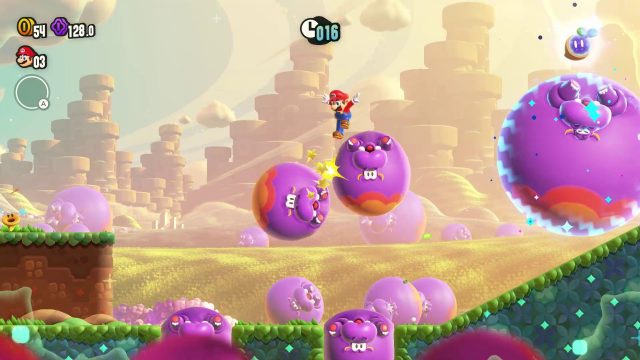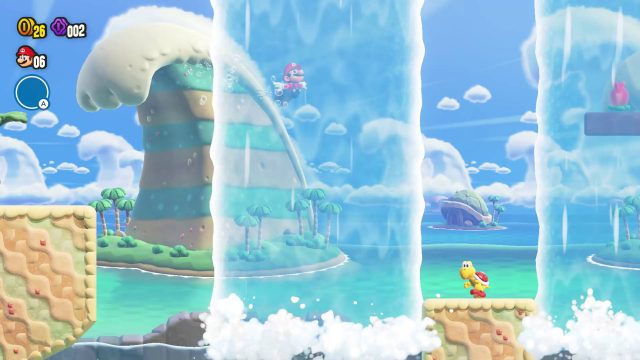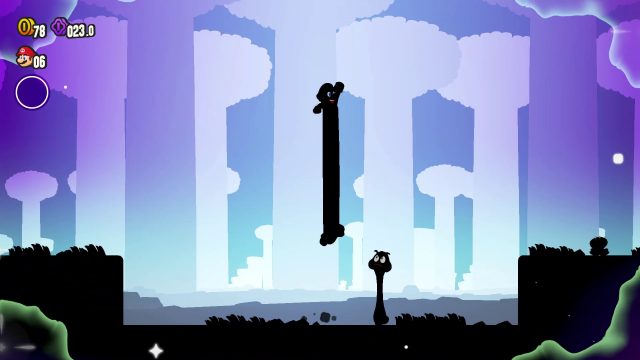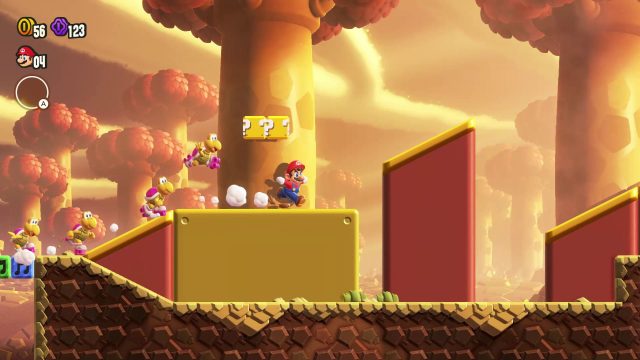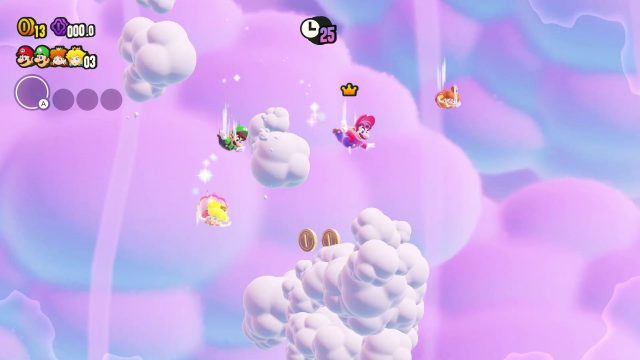Incredible variety of new enemy types; boss battles have been spiced up; Afghani is a perfect replacement for Martinet as Mario and Luigi; the graphics are stunning, mixing colors, themes, and settings to produce a wild visual tapestry; controls are precise and sharp as ever; Badges are a smart way to optionally modify gameplay for those who want an easier or harder time; multiplayer is seamlessly integrated, including the Dark Souls-like online play; tons of secrets and stages to explore
Music is a bit forgettable outside of returning tunes from previous games; could stand to be slightly more difficult
As noted in my review of Sonic Superstars, it’s been a long time since fans have had a proper face-off between hedgehog and plumber—especially a pair of their 2D platformers, to boot. In the case of Super Mario Bros. Wonder, this is the first true new 2D installment for the series since the release of New Super Mario Bros. U on Nintendo Wii U back in 2012. In the 11 years since then it’s fair to say fans have seen a great deal of innovation with the Mario brand when it comes to 3D adventures, but the “New” had arguably worn off of the New Super Mario Bros. series by the time New Super Mario Bros. U Deluxe launched on Nintendo Switch.
Don’t get me wrong, the NSMB games were fun but had become formulaic over time, in particular as it pertains to the visuals of each game, which all started to blur together. With Wonder, however, Nintendo has decided to ditch the “New” branding and really stretch its wings to try something, well, new. Fresh. Innovative. Wonderful. All of these words are apt descriptors of Wonder, a game that does wildly inventive things to make Super Mario Bros. feel every bit as mesmerizing as the best installments in the series. From new power-ups to some of the best visual design work ever featured in a Mario game, Wonder is truly in a league all its own.
As ever, Bowser is back to terrorize Mario and his companions. The Koopa King is assaulting the Flower Kingdom and with the help of Prince Florian, players will set out to stop him. Besides the mustachioed plumber, players can also choose between Luigi, Peach, Daisy, Yellow Toad, Blue Toad, Toadette, Yoshi, Light-Blue Yoshi, Red Yoshi, and Nabbit. It’s an enormous roster, but it serves a practical purpose as much as fan service. The Yoshis are all impervious to harm, have access to their signature tongue attacks and flutter jump, and can’t use power-ups. Nabbit is largely the same as the Yoshis, just minus the boosted jumping and slurping. They’re a great intermediary choice for those who want to make the game less challenging.
It’s a little disappointing that the Yoshis have been relegated to what is ostensibly the game’s easy mode, but the different mechanics they bring to the table help to spice things up. The other characters, meanwhile, all control identically. No fluttering for Luigi, no faster run speed for Toad, no floating for Peach—no matter who is picked, they all handle the same. That might disappoint some fans at a glance, but anyone who was hoping for more depth from the controls will find it in Wonder’s Badge system. It’s here that players get to personalize the experience and find a playstyle that fits themselves.
Not unlike how Badges function in the Paper Mario games, in Wonder they afford players a whole host of new abilities and buffs to experiment with. Wall-Climb Jump, Fast-Dash, Floating High Jump, and many others provide players with a plethora of ways to interact differently with the game world. What’s more, the Badges can sometimes even add to the difficulty level. The Jet Run Badge, for instance, sends character careening across the screen, making it harder to navigate platforms but with the benefit of greater speed. For players looking to push themselves, Badges add a nice layer of depth to the proceedings.
Badges also alternatively serve to make things easier, but intermediately so when compared to the buffs granted by the Yoshis and Nabbit. For example, the Auto Super Mushroom Badge will make a player automatically start a stage at full size. So, if being invincible the entire game sounds too easy, this is a nice middleground that softens the challenge but doesn’t entirely remove it. Badges are perfectly balanced and, best of all, entirely optional. Those who want the vanilla Mario experience can get it (although the midair flail that was first incorporated in New Super Mario Bros. remains, but can also be similarly ignored if so desired).
What stands out more than anything when looking at Wonder for the first time is how stunningly detailed and gorgeous the game is. Nintendo went through a lot of painstaking effort to elevate the character models and animations in Wonder. Comparing NSMBU to Wonder, it’s shocking how much more detailed Mario and friends have become, despite both games being in HD. For Wonder, the characters are constantly emoting and reacting to the world around them. Even something as simple as going through a pipe has small touches added in, like Luigi reaching his hand out behind himself to pull his cap back in on his way through.
This lavishness extends into the design of the enemies and world, as well. The enemies are every bit as emotive as the heroes; players will frequently see minions such as Goombas doing things like snoozing on the job. It’s the new foes that truly shine in Wonder. Baddies like Mumsies need a more tactical approach to defeat, requiring players to sneak around them and tug on a handle that protrudes from their backs to unravel their bandages. Skeddadlers, meanwhile, run away from our heroes while shooting projectiles backwards as they do so, making them tricky to dispatch. There are many other new baddies that have been introduced and all provide delightful new dangers to navigate (and will all likely be immortalized in plastic by JAKKS Pacific at some point).
The ingenuity then extends into the game world itself. The overhead, 3D map of Super Mario 3D World Deluxe, Kirby and the Forgotten Land, and other Nintendo titles is utilized here, and it’s a nice break from the usual rigid paths that 2D Mario maps commonly have. It’s also laden with secrets, with hidden paths to find all throughout the Flower Kingdom. Some of the views on the map screen are also rather extraordinary when it comes to the sense of depth and scale that they evoke. No single part of the kingdom totally sticks to the theme that it has, which means some of the landscapes are real head trips. From the golden waters of Shining Falls to the scorching lava of Deep Magma Bog, there are vistas that regularly took my breath away.
The stages, meanwhile, have cranked everything up to an 11. The visual fidelity is the easiest thing to latch onto and praise, and for good reason, as the graphics are bold and impressive. Taking a cue from Super Mario Odyssey, the surroundings in Wonder are often surreal. Rather than focus on realism or sticking to a certain theme, the designers have been unshackled and mix setting, textures, and colors with abandon. As a result, the stages are a sublime menagerie of fantasy settings that have players hooked to see what will come next. The designers even give Bowser and Bowser, Jr. new looks that are legitimately iconic.
At the heart of the stages is the actual level design, and it’s here that the real soul of Wonder can be found. Stages are fantastically laid out. The challenges range from basic pits and hazards like spikes, to more elaborate fair like bouncing atop enormous inflatable enemies launching both vertically and horizontally across the screen. The first time a Hoppo rolls across the ground it’s a moment that really cements just how wild and unpredictable Wonder is. Sure, there are plenty of the classic elements and enemies that have been a part of the franchise for decades now, but the abundance of crazy, new ideas and foes is every bit as prevalent. It’s rather flabbergasting to find that a series now decades old can continue to pump out so many fresh ideas and concepts.
On that note, perhaps the funnest of the game’s interactions comes from the Wonder Flowers. They’re typically tucked just out of sight and, once activated, create massive changes to the stage. Enemies balloon up astronomically in size, pipes come to life and shimmy across the ground, and Star Men rain from the skies. The multitude of Wonder Flower segments not only diversify the gameplay, but they also lead to alternate routes and stages. Thankfully, as fun as the Wonder Flower gameplay is, Nintendo showed just the right amount of restraint when implementing them, never relying too much on their gimmicks and never having them outstay their welcome.
As with the NSMB series, four-player multiplayer is back. The couch co-op is mostly unchanged, but it’s worth noting that player collision is removed, so no more bouncing on top of other players or throwing them. Which is an odd choice, given the mayhem and fun that some people had when trying to sabotage one another. Instead, Wonder pushes for a more properly collaborative experience. This can be seen in particular with Yoshi, who players can jump atop and create a fascinating dynamic where the Yoshi player handles movement and the rider can do things like shoot fireballs. It’s all good fun if you’re into multiplayer Mario shenanigans.
For those wanting an online way of experiencing co-op, Nintendo has implemented a Dark Souls-esque system where other players appear as shadowy phantoms in the background. While players aren’t directly interacting with one another in this mode, they can do things like help revive the fallen or leave Standees (of which there are a ton of to collect, not unlike the stamps in Super Mario 3D World Deluxe) as markers throughout a stage. It’s all seamlessly integrated, although doubtlessly some will wish that Wonder had true, uncompromised online multiplayer. But hey, for what it is, it’s rather clever and well done.
One last positive I’d like to mention is how fun the boss fights are. The Bowser, Jr. encounters start off like the typical Boom Boom battles of old, but thanks to the introduction of Wonder Flowers quickly evolve into something far more fascinating. It’s a small thing, but as I’ve mentioned throughout this review, I repeatedly found myself taking time to pause and marvel at how much ingenuity the design time was able to mine from the standard Mario formula of platformers. It’s a testament to the adaptiveness of the series as much as the talent of the team itself.
If there’s anything negative to say about Wonder, it might be that I didn’t find the music especially captivating. It’s fine, of course; the soundtrack is not a terrible, unlistenable mess—it’s just not all that memorable. Ironically, in a game that so successfully provides new things to the mix, the only tracks that stood out to me were the ones from previous games like Super Mario Sunshine. I do want to tip the proverbial cap to Kevin Afhani, since we’re on the topic of audio. The entire cast does a delightful job here, but Afghani, the first voice actor to take on the roles of Mario and Luigi in a game since the retirement of Charles Martinet, has slipped seamlessly into the roles. He doesn’t sound exactly like Martinent, but he is very close, and dare I say he adds his own touch to each character. I sincerely hope Nintendo has offered him a long-term contract.
I have certainly enjoyed the NSMB games since their inception on Nintendo DS, but I must admit that Wonder had surpassed those games in virtually every way. I felt a sense of whimsy and joy playing Wonder that took me back to the days of Super Mario Bros. 3 and Super Mario World. The game is packed with secrets, filled with challenge, and entertained me for hours.The pacing, the graphics, the controls—this is a masterclass in game desing. Wonder has reconfirmed for any doubters out there that the Mario brand is still brimming with potential for new gameplay ideas. Wonder is an essential game for Switch players that is highly recommended.




 ShareThis
ShareThis